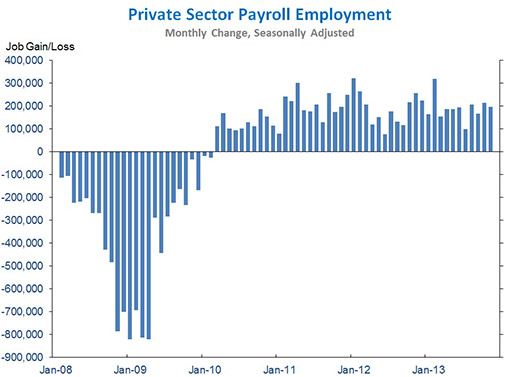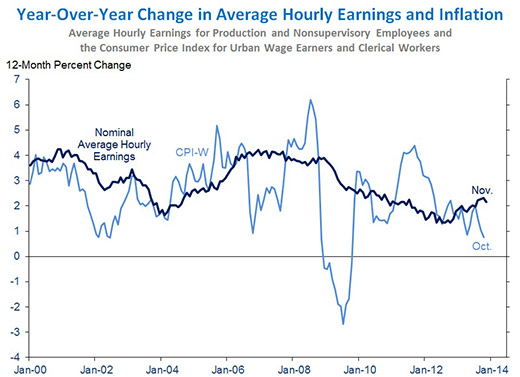The Employment Situation in November
With solid job growth in November – in addition to strong data on manufacturing activity and auto sales – it is clear that the recovery continues to gain traction. Today’s report was yet another reminder of the resilience of America’s private sector following the disruptive government shutdown and debt limit brinksmanship in the first half of October. Nevertheless, today’s jobs numbers show that too many Americans who have been unemployed for 27 weeks or longer are still struggling to find jobs. That is why the President is calling on Congress to pass the extension of emergency unemployment insurance before it expires at the end of the year, just like they have always done when long-term unemployment remains elevated. The President also continues to work to increase overall growth while ensuring that growth is shared broadly in the form of higher wages and more mobility, which is why he is fighting for a minimum wage increase and expansion of educational opportunities.
FIVE KEY POINTS IN TODAY’S REPORT FROM THE BUREAU OF LABOR STATISTICS
1. America’s resilient businesses have added jobs for 45 consecutive months, with private sector employment increasing by more than 8 million over that period. Today we learned that total nonfarm payroll employment rose by 203,000 in November, with 196,000 of that increase in the private sector. Private sector job growth was revised up for September (to 168,000) and October (to 214,000) so that over the last three months, private employment has risen by an average of 193,000 per month.

2. Real average hourly earnings for private production and nonsupervisory workers rose 1.4 percent in the twelve months ending in October, the largest increase since 2009, and today’s data on nominal wages in November suggest that this growth likely continued. These data signal that the recovery in the labor market continues to progress, but are also a reminder that more work remains to boost not only job creation but also earnings. The real wage growth observed in recent months reflects both low inflation and a pickup in nominal wage growth, which continued into November, when the average private sector production and nonsupervisory worker earned $20.31 per hour, up 2.2 percent relative to a year earlier (data on inflation and real wages in November will be available on December 17). Looking over a longer period, real average hourly earnings for production and nonsupervisory workers have risen on net only about 3 percent since 1979 – a period when labor productivity rose by more than 90 percent. These statistics underscore the importance of taking steps to ensure that even as our overall economy continues to strengthen, those striving to get into the middle class are not left behind.

3. While many retailers add additional workers to accommodate heightened customer traffic during the holiday season, the magnitude of holiday hiring differs substantially across retail subsectors. The chart below shows the varying extent of seasonal hiring by comparing the raw, unadjusted level of payroll employment in a given sector to the seasonally adjusted level. Sectors with higher ratios can be said to exhibit a more pronounced seasonal hiring pattern. In November, the overall retail trade industry had 15,773,100 payroll positions (not seasonally adjusted), which represents 15,320,500 positions on a seasonally adjusted basis – the unadjusted level is about 3 percent higher than the adjusted level. For clothing and clothing accessory stores, the sector with the most pronounced holiday hiring effect, unadjusted employment was about 10 percent higher than the seasonally adjusted level in November. In contrast, for building material and garden supply stores, unadjusted employment was about 2 percent less than seasonally adjusted employment in November – perhaps unsurprising, since cold weather prevents Americans in many parts of the country from gardening during the winter months. While the unadjusted data can provide interesting insights into the patterns of our economy and society, the seasonally adjusted data are the best benchmark of the economy’s progress. And crucially, the seasonally adjusted data show that overall hiring in the retail trade sector has been solid in recent months, with employment rising by an average of 36,000 per month over the last six months.

4. While still unacceptably high, the unemployment rate fell 0.3 percentage points to 7.0 percent, the lowest in five years, and the Bureau of Labor Statistics’ broadest alternative measure of labor underutilization also posted a notable decline. The “U-6” rate is the broadest alternative measure of labor underutilization because it includes the unemployed, persons working part-time for economic reasons, and those marginally attached to the labor force. This measure fell by 0.6 percentage point in November, the largest one-month drop on record (following a shutdown-related increase in October), and also reached its lowest level in five years. The concurrent improvement in the broadest official alternative measure of labor underutilization is another signal that the labor market is healing. The chart below shows that over time, these two series tend to move in the same direction, but that the U-6 is always substantially higher than the official unemployment rate in both recessions and recoveries.

5. All of the reduction in unemployment in November was due to a drop in the number of short-term unemployed, while the average duration of unemployment rose to 37.2 weeks and remains markedly elevated. The median duration of unemployment has come down from its peak of 24.8 weeks to 17.0 weeks in November, but the average duration has not come down as much from its peak of 40.7 weeks. The substantial gap between the average and median duration of unemployment suggests that many of the remaining unemployed are concentrated at extremely lengthy durations of unemployment. The additional weeks of unemployment insurance offered as a result of the Emergency Unemployment Compensation (EUC) program first signed into law by President Bush in 2008 serve as an important lifeline to those who are still struggling to get back on their feet in the wake of the crisis. The critical need to extend the EUC program before it expires at the end of this year is outlined in this report, released earlier this week by the Council of Economic Advisers and the Department of Labor.

As the Administration stresses every month, the monthly employment and unemployment figures can be volatile, and payroll employment estimates can be subject to substantial revision. Therefore, it is important not to read too much into any one monthly report and it is informative to consider each report in the context of other data that are becoming available.
White House Blogs
- The White House Blog
- Middle Class Task Force
- Council of Economic Advisers
- Council on Environmental Quality
- Council on Women and Girls
- Office of Intergovernmental Affairs
- Office of Management and Budget
- Office of Public Engagement
- Office of Science & Tech Policy
- Office of Urban Affairs
- Open Government
- Faith and Neighborhood Partnerships
- Social Innovation and Civic Participation
- US Trade Representative
- Office National Drug Control Policy
categories
- AIDS Policy
- Alaska
- Blueprint for an America Built to Last
- Budget
- Civil Rights
- Defense
- Disabilities
- Economy
- Education
- Energy and Environment
- Equal Pay
- Ethics
- Faith Based
- Fiscal Responsibility
- Foreign Policy
- Grab Bag
- Health Care
- Homeland Security
- Immigration
- Innovation Fellows
- Inside the White House
- Middle Class Security
- Open Government
- Poverty
- Rural
- Seniors and Social Security
- Service
- Social Innovation
- State of the Union
- Taxes
- Technology
- Urban Policy
- Veterans
- Violence Prevention
- White House Internships
- Women
- Working Families
- Additional Issues

